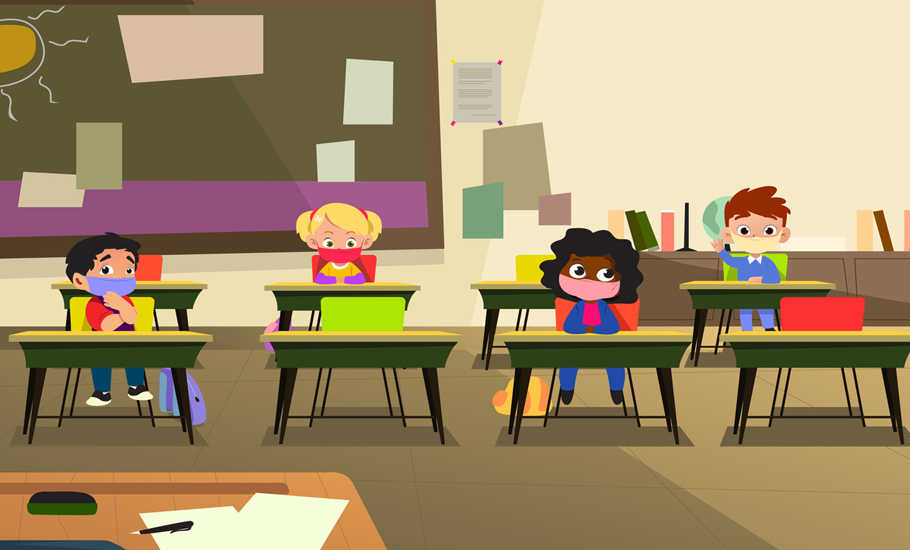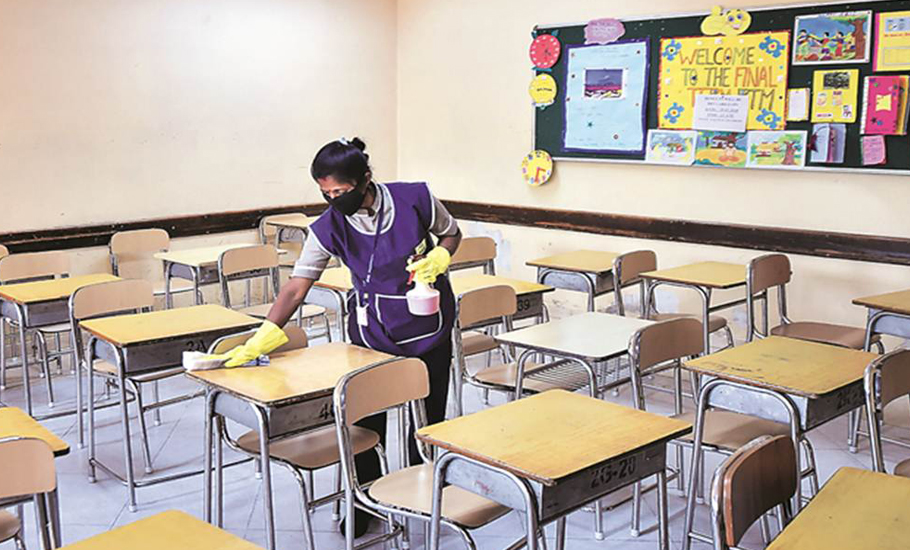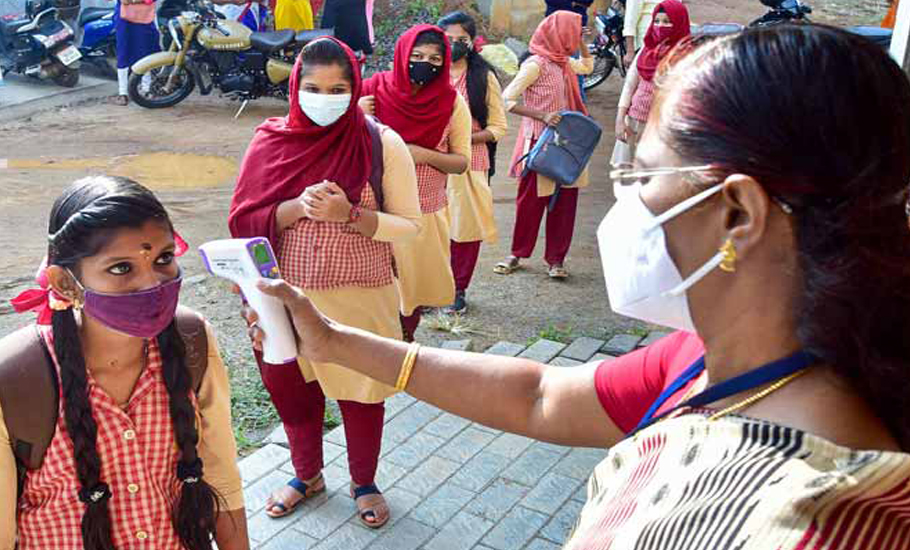
- Home
- News
- Analysis
- States
- Perspective
- Videos
- Education
- Entertainment
- Elections
- World Cup 2023
- Features
- Health
- Budget 2024-25
- Business
- Series
- NEET TANGLE
- Economy Series
- Earth Day
- Kashmir’s Frozen Turbulence
- India@75
- The legend of Ramjanmabhoomi
- Liberalisation@30
- How to tame a dragon
- Celebrating biodiversity
- Farm Matters
- 50 days of solitude
- Bringing Migrants Home
- Budget 2020
- Jharkhand Votes
- The Federal Investigates
- The Federal Impact
- Vanishing Sand
- Gandhi @ 150
- Andhra Today
- Field report
- Operation Gulmarg
- Pandemic @1 Mn in India
- The Federal Year-End
- The Zero Year
- Premium
- Science
- Brand studio
- Home
- NewsNews
- Analysis
- StatesStates
- PerspectivePerspective
- VideosVideos
- Entertainment
- ElectionsElections
- Sports
- Loading...
Sports - Features
- Budget 2024-25
- BusinessBusiness
- Premium
- Loading...
Premium

Back to school: How kids, parents and teachers are adjusting to the new normal

As schools across India are reopening and students try to resume their education, The Federal attempts to get answers to some out-of-syllabus questions to know how children are coping, what their parents and teachers have to say and, most importantly, what all has changed since March 2020. Where did the children go? It’s been 19 months since headmaster PR Chowdury last heard the...
As schools across India are reopening and students try to resume their education, The Federal attempts to get answers to some out-of-syllabus questions to know how children are coping, what their parents and teachers have to say and, most importantly, what all has changed since March 2020.
Where did the children go?
It’s been 19 months since headmaster PR Chowdury last heard the words ‘good morning, sir’ in-person. An eerie stillness pervades the corridors of the Kanaknagar SD Institution in West Bengal’s Hingalganj that once echoed with the rush of giggling students jostling for space. Now that the government-aided school is set to reopen on November 16, Chowdury is anxious if the silence will continue. Chowdury’s job is not simple. He has to first look for his students, locate them and then bring them back to their classrooms.
“Many of our students have left the state in search of work to distant places. We now need to identify and bring them back to classrooms,” says Chowdury. While only about 30 per cent of the students of this co-educational school attended the online classes, many of these absentee students dropped out of schools. Several others could not attend the online classes due to the lack of access to devices.
As schools across the state gear up to resume offline classes from November 16, educational institutions in rural areas face the problem of ‘missing students’. The challenge now is to bring them back to classrooms.
Multiple surveys have been warning that children across states are being put into work by parents desperate for money. Teachers fear many of these children will never return to school. “The tragic impact of the situation is palpable as children have started working, often leaving homes to slog in brick kilns or in farms, if not that then to get married, especially the girls,” says one of them.
Students’ mental health suffers
Miles away in Delhi, the parents of Meha Thakur (name changed) are deeply worried about their teenage daughter’s well-being. Over a year ago, as the city was sinking into the vortex of an intensifying pandemic, Meha’s singular worry was that she’ll miss out on “all the fun and excitement” students her age associate with.
Sadly for Meha, a student of the DAV Public School’s RK Puram branch in Delhi, the pandemic forced schools all over to remain shut and move to virtual classrooms, which also meant extra-curricular activities were suspended indefinitely.
Meha, like all her classmates, spent the past year attending classes online and even when the pandemic abated a little, her parents made sure that she remained indoors. A few months back, the Delhi government allowed schools to reopen for students of Class 9 and onwards, provided the occupancy in classrooms was kept below 50 per cent and Covid guidelines were strictly followed inside school premises. Meha was among a handful of students who returned to attend classes in school. Then, after attending just two in-person classes, she was back to her virtual classroom because heavy rains in Delhi forced her school to suspend physical classes again.

Last month, as Delhi’s Covid positivity rate stabilised below 1 per cent and fresh daily cases continued to stay below 50 – the lowest since the beginning of the pandemic in March 2020 — the Delhi government allowed schools to reopen for all students from November 1.
However, something about Meha, now in Class 12 and preparing for her first pre-board exams, had changed, say her parents. “She doesn’t seem excited at the prospect of returning to school anymore. When we told her that she can attend physical classes after the Diwali weekend, she said she wanted to continue with online sessions,” her father, Rishabh, tells The Federal.
“She had spent all of last year complaining about not being able to go to school, to meet her friends or attend her sports sessions or not being able to go out for picnics. Now that things are getting back to normal, she refuses to go out,” the worried father adds.
Meha, according to her mother Drishti, has always been good at her studies and sports. She even showed a lot of promise in public speaking competitions. “Now, her academic performance has been slipping even though she never misses her online classes.”
‘No vaccination means our children are not safe’
Bengaluru-based Rajeshwari (name changed) is another anxious parent. The mother of a Class 10 student says she was forced by the school management to sign a consent letter for in-person classes.
“Initially, I wasn’t okay. I even told the headmistress that children have not been vaccinated while the rest of us [adults] have completed two doses of vaccination. This is why I fear sending my daughter to school,” she tells The Federal.
But a few weeks later when the government announced the reopening of classes, some of the parents got confused. They feared if their children stick to home studies, they may lag behind and fail the exams. “I still preferred to wait until every parent gave their consent on the school’s WhatsApp group. I was one of the last to agree.”
Rajeshwari says she had decided to stop sending her child to school if the attendance was less than 70 per cent in the initial days. But to her surprise, the first few days saw 100 per cent attendance. “Online classes have been completely discontinued. Now, students are left with no option but to go back to school,” she adds.
In Kolkata, similar worries made a parent move the high court on November 8 over what the petitioner claimed “unplanned” reopening of schools in the state.
Sudip Ghosh Choudhury, a lawyer himself, argued that since vaccination has not yet started for those below 18 years of age, in-person classes would put them at increased risk of contracting the virus, especially since they have to stay inside classrooms for long hours. He appealed to the court to constitute an expert committee to look into the matter. The public interest litigation is likely to come up for hearing on November 11.
However, it is mostly parents from the urban centres who are showing reluctance to send their children to the school, says a teacher from Chennai who wishes to remain anonymous. “Parents from rural areas are showing more enthusiasm,” she says. And there is a reason for that.
‘Online was never really an option, school also means food ’
Online classes were never really an option for children among both rural and urban poor. “Most parents here struggled to provide devices to their children. When there is no food to feed, to ask such children to join online classes is a cruel joke,” says K Reshma, a Bengaluru-based social activist. “For them offline is the only way, if at all.”
Thyagarajan, a parent from Thanjavur in Tamil Nadu, agrees. “The pandemic-induced lockdown forced many students to drop out of school and enter the labour market. However, many parents also realise the importance of education. They are pushing their children to attend in-person classes fearing the children would lose interest in studying and get attached to the work they are engaged in,” he says.
Kotresh Hiremath, a government high school teacher in Karnataka’s Raichur district, has a clearer picture to offer on attendance rate. In his school, the attendance remained at 70 per cent. “That’s not because of the fear of contracting COVID. The enrolment in general remained low this year. Also, this happens to be the peak agriculture season.” In the same district, he says, attendance in primary schools has been picking up with mid-day meals resuming from October 21.
An education department official in Dehradun says resuming mid-day meals last week has shown encouraging results in his state as well.
“Mid-day meals were resumed instead of compensating the students through the Direct Benefit Transfer scheme,” said the official.
He looks at it as a positive sign since the number of students of classes 1 to 8 in the state government-run schools has gone up to 6.97 lakh. This year, around 30,000 new enrolments took place.
Students enthused, but confusion prevails
In idyllic Kerala, data released by the state government shows 80 per cent of students turned up within the first three days. This, many believe, shows that parents and students are relieved with the reopening of schools.
According to V Sivankutty, the Minister for General Education, schools having less than a thousand students would function in two shifts – three days a week each. “Those having more than 1,000 would divide the students in batches, limiting the attendance to 25 per cent in one shift. Offline classes are being conducted half a day and the rest of the time is dedicated to online classes for those who are unable to turn up.”

A similar enthusiasm was seen in schools in Maharashtra as well. Darshana Korke, Principal of New English School in Pune, tells The Federal, “The response has been great. It was evident from the attendance in pre-Diwali days when schools first reopened after the pandemic.”
Many schools in Maharashtra have currently opted for the hybrid teaching structure (simultaneous online and offline lessons). “In this method, teachers conduct classes while sitting in the schools in front of students and the same is broadcast online for those who can’t attend in-person,” said another school teacher.
Satish Gavali, principal of Modern High School, seems happy, especially with the response from rural regions. “The students are really eager to come back to school. The attendance has reached above 90 per cent in many places,” says Gavali, who also happens to be a member of the headmasters association.
However, all this comes with added confusion. For instance, Gavali is worried about potential space crunch that schools might have to face while running in full-capacity under COVID 19 protocols. “Previously, 100 students could be accommodated in two classes. But as per the new protocols, we need at least three classrooms for the same number of kids. Hence, it would be very difficult to operate at full capacity and follow all guidelines.”
In Tamil Nadu, the real confusion is over the reopening of private schools. While schools for classes 9 to 12 started on September 1, students of classes 1 to 8 were back to school on November 1. But most private schools are still running online classes for lower grades. These schools, including the ones affiliated to the Council for the Indian School Certificate Examinations, are gradually facing pressure to handle in-person classes, especially after CBSE schools reopened for higher classes.
This lack of uniformity in the manner in which schools have resumed functioning has led to enormous confusion. “The government’s rules and guidelines for resuming physical classes may be uniform but the way they are being implemented by different schools isn’t. There is also a general reluctance among parents to send their kids to school because of the fear that the pandemic has put in all our minds. So, while some schools may be getting a good response to physical classes, others are getting just four-five students in each class,” says AK Singh (name changed), whose sons are enrolled at Gurgaon’s Sri Ram International School.
Singh says this confusion is compounded by the fact that in the wider National Capital Region (NCR) — Delhi, Ghaziabad, Noida, Faridabad, Gurgaon — different schools need to follow different guidelines as they fall under jurisdiction of different state governments. “So, if I am sending my child to a Delhi school but my neighbour’s child goes to a Noida school, the experience may be totally different. When we talk among ourselves, we come back completely confused about what really is happening or what exactly we are supposed to follow.”
If parents feel stressed, teachers are a harried lot
The Thakurs from Delhi have a litany of complaints about the school administration and teachers for not being “supportive enough” through the pandemic. “They conducted the online classes regularly, but that was it. Most of the time, teachers simply emailed PDFs of the study material to students and there was no real teaching being done. When we spoke to some of the teachers, they complained that they were overworked because none of them had prior experience of virtual classrooms.”

“We understand they spent a lot of time beyond school hours to prepare PDFs, presentations and reading material for all the classes but while we empathise with the teachers, how does this help our child?” asks Meha’s mother.
While their grievances sound genuine, teachers at the DAV school have their own list of complaints about this new normal in school education. “Whatever concerns parents and students have are perfectly justified but it is wrong to suggest that teachers and schools are having a gala time,” a teacher at DAV RK Puram tells The Federal.
The pandemic, she says, caught everyone unawares. “No one could have imagined the things that unfolded since. We had no experience in conducting online classes and had barely a few months to pick up this new skill,” says Aruna Sharma (name changed).
Sharma says just when teachers became adept at online classes, the Delhi government said offline classes can begin with 50 per cent occupancy. “Initially, we had separate timing for teaching online and offline. So, we were spending twice the amount of time doing the same work.”
Then the government came up with hybrid classes, which had its own problems. “Online students felt those attending physical classes were getting better treatment. Parents were, naturally, upset. But what are we to do? Where do we go with our problems?” asks Sharma.
A private school teacher from Tamil Nadu claims most school managements haven’t paid salaries to their staff for many months. “Some schools have kept the original certificates of teachers in custody to prevent them from looking for other jobs,” says the teacher, requesting anonymity.
Working under such conditions is not easy, she adds. “Everyone is under a lot of pressure.”
(With inputs from Prabhu Mallikarjunan, N Vinoth Kumar, Samir K Purkayastha, Puneet Nicholas Yadav, Akash Chandrashekhar Gulankar, Shahina KK)

